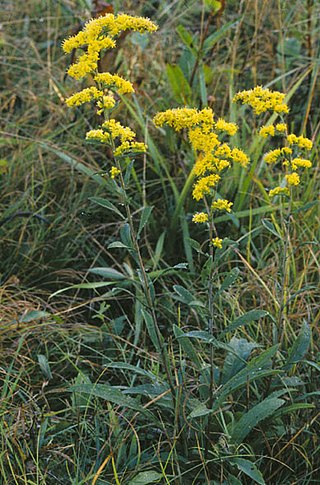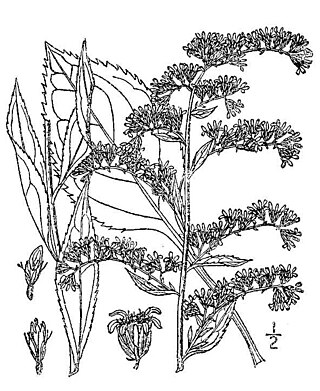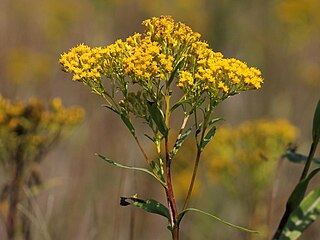
Solidago, commonly called goldenrods, is a genus of about 100 to 120 species of flowering plants in the family Asteraceae. Most are herbaceous perennial species found in open areas such as meadows, prairies, and savannas. They are mostly native to North America, including Mexico; a few species are native to South America and Eurasia. Some American species have also been introduced into Europe and other parts of the world.

Goldenrod is a common name for many species of flowering plants in the sunflower family, Asteraceae, commonly in reference to the genus Solidago.

Solidago canadensis, known as Canada goldenrod or Canadian goldenrod, is an herbaceous perennial plant of the family Asteraceae. It is native to northeastern and north-central North America and often forms colonies of upright growing plants, with many small yellow flowers in a branching inflorescence held above the foliage. It is an invasive plant in other parts of the continent and several areas worldwide, including Europe and Asia. It is grown as an ornamental in flower gardens.

Solidago nemoralis is a species of flowering plant in the family Asteraceae. It is native to North America, where it is widely found in Canada and the United States. Its common names include gray goldenrod, gray-stem goldenrod, old-field goldenrod, field goldenrod, prairie goldenrod, dwarf goldenrod, and dyersweed goldenrod.

Solidago rugosa, commonly called the wrinkleleaf goldenrod or rough-stemmed goldenrod, is a species of flowering plant in the family Asteraceae. It is native to North America, where it is widespread across eastern and central Canada and the eastern and central United States. It is usually found in wet to mesic habitats.

Solidago californica is a species of goldenrod known by the common name California goldenrod.

Pityopsis ruthii is a rare species of flowering plant in the family Asteraceae known by the common name Ruth's golden aster. It is endemic to the US state of Tennessee, where it is known only from Polk County. It is threatened by the modification of its habitat. It is a federally listed endangered species.

Solidago spithamaea is a species of flowering plant in the family Asteraceae known by the common name Blue Ridge goldenrod. It is native to a very small region around the border between North Carolina and Tennessee in the United States. Its three remaining populations are threatened by the loss and degradation of its habitat. It is a federally listed threatened species of the United States.

Solidago houghtonii is a rare North American species of flowering plant in the family Asteraceae known as Houghton's goldenrod. It is native to southern Ontario, Canada and the northern United States. It is threatened by the loss and degradation of its habitat. It is a federally listed threatened species of the United States and it is designated a species of special concern by Canada's Committee on the Status of Endangered Wildlife in Canada.

Spiraea virginiana is a rare species of flowering plant in the rose family (Rosaceae) known by the common names Virginia meadowsweet and Virginia spiraea. It is native to the southern Appalachian Mountains, where it has a distribution scattered across nine states. However, most populations are very small and poor in quality. It is threatened by disturbances in the hydrology of its habitat, introduced species of plants, and other threats. It is a federally listed threatened species of the United States.

Solidago missouriensis is a species of flowering plant in the family Asteraceae known by the common names Missouri goldenrod and prairie goldenrod. It is native to North America, where it is widespread across much of Canada, the United States, and northern Mexico. It grows from British Columbia east to Manitoba, south as far as Sonora, Coahuila, Texas, and Mississippi.
Solidago verna is a species of flowering plant in the aster family known by the common names springflowering goldenrod and spring goldenrod. It is native to North Carolina and South Carolina in the United States.

Solidago villosicarpa is a species of flowering plant in the family Asteraceae known by the common names hairy-seed goldenrod, coastal goldenrod, glandular wand goldenrod, and shaggy-fruit goldenrod. It is endemic to North Carolina in the United States, where there are only four known populations.

Solidago arguta, commonly called Atlantic goldenrod, cut-leaf goldenrod, and sharp-leaved goldenrod, is a species of flowering plant native to eastern and central North America. It grows along the Gulf and Atlantic states of the United States from Texas to Maine, inland as far as Ontario, Illinois, and Kansas. It is primarily found in areas of woodland openings, such as outcrops or clearings.

Solidago elongata, commonly called West Coast Canada goldenrod or Cascade Canada goldenrod, is a North American species of flowering plants in the family Asteraceae. It is native to western Canada, western United States, and northwestern Mexico, primarily in British Columbia, Washington, Oregon, California, and Baja California, with a few populations in Nevada and Idaho. It grows in the Coast Ranges, the Sierra Nevada, the Cascades, and other mountain ranges in the region.

Solidago nana is a North American plant species in the family Asteraceae, with the common names baby goldenrod and dwarf goldenrod. The species is native to deserts and mountainsides in the western United States, from the Rocky Mountains to the Great Basin in the states of Idaho, Montana, Nevada, Utah, Wyoming, Colorado, Arizona, and New Mexico.

Solidago sciaphilia is known as shadowy goldenrod or cliff goldenrod. The species is endemic to bluffs along the Mississippi River in southern Minnesota, and the driftless area of southwestern Wisconsin, northern Iowa and Illinois. Throughout its range, S. sciaphila is strongly associated with dolomite and sandstone bedrock, especially dry cliffs. It can be similar to Solidago speciosa but has more serrate lower and mid stem leaves and is generally smaller to much smaller when growing in pockets of shallow soil on cliffs. Small plants are similar to Solidago hispida in general appearance. Blooming occurs late August through late September; fruiting occurs throughout September. Shadowy Goldenrod is considered a Special Concern species in Wisconsin and Minnesota, and considered threatened in Illinois. This species can be significantly impacted by rock climbing activities.
Solidago rupestris , the rock goldenrod or riverbank goldenrod, is a North American species of flowering plants in the family Asteraceae. It is found in the eastern United States, found today in the States of Maryland, Virginia, Kentucky, and Tennessee. There are historical records of it formerly growing in Indiana and Pennsylvania as well, but these populations now appear to have been extirpated.

Solidago sect. Ptarmicoidei is a section of flowering plants in the genus Solidago. They are sometimes considered a separate genus: Oligoneuron. Like related species they are known as goldenrods. This section contains seven species of perennial herbs, all native to North America. They are distinguished from other goldenrods by their corymbiform flowerheads, which are flat or rounded in profile and about as broad as tall or broader, for which they are sometimes called flat-topped goldenrods.
John Cameron Semple is a botanist, cytotaxonomist, professor emeritus, and adjunct professor at the University of Waterloo in Ontario, Canada. He was born in Boston and earned a degree of Bachelor of Science in 1969 from Tufts University, followed in 1971 and 1972 by Master of Arts and Doctor of Philosophy degrees from Washington University in St. Louis. Semple is known for his work with members of the tribe Astereae, particularly goldenrods, American asters, and goldenasters, and he maintains the University of Waterloo Astereae Lab website. Semple's wife is Brenda, and in 2013, he named a newly discovered goldenrod species Solidago brendiae in honor of her.


















